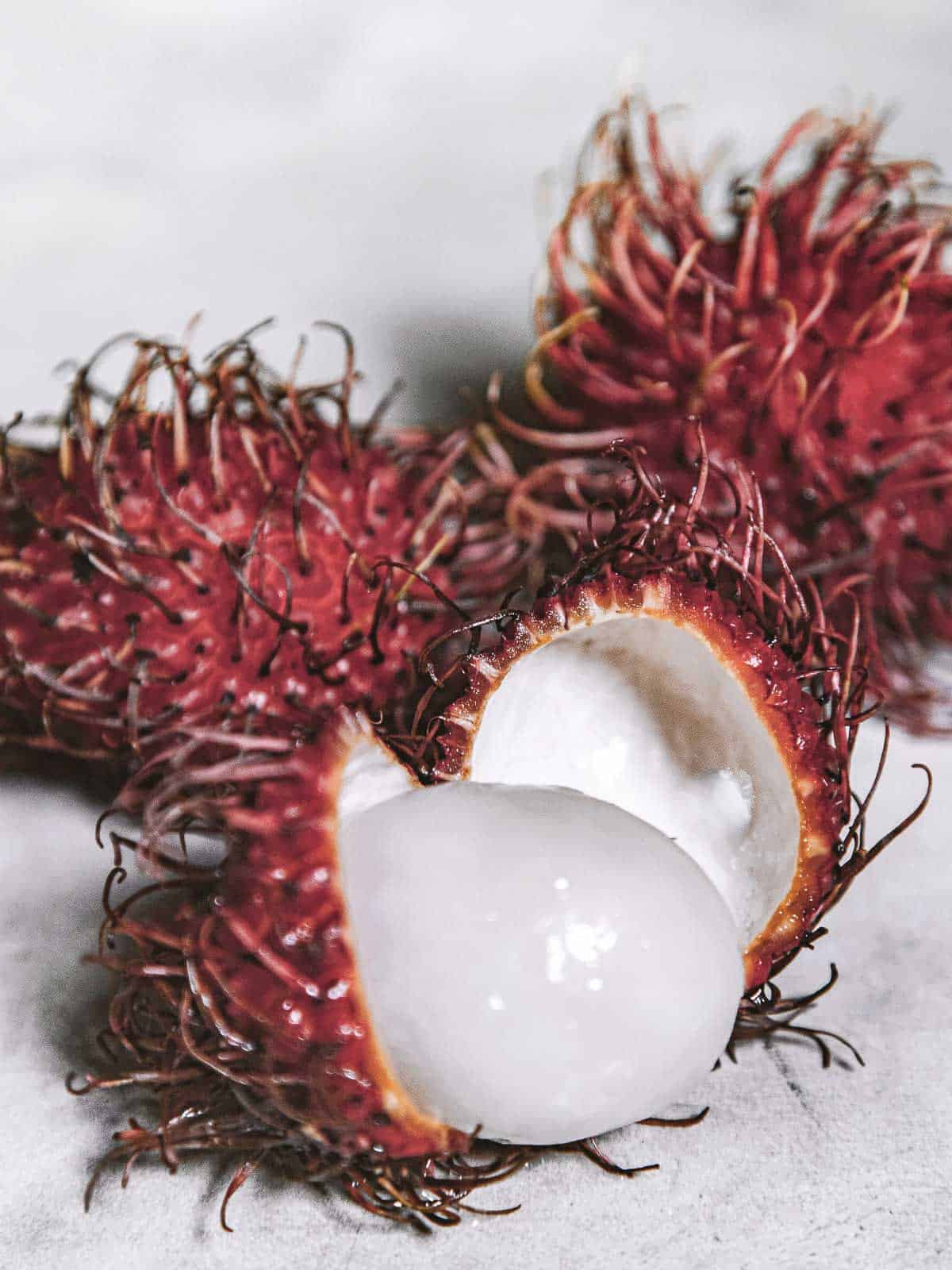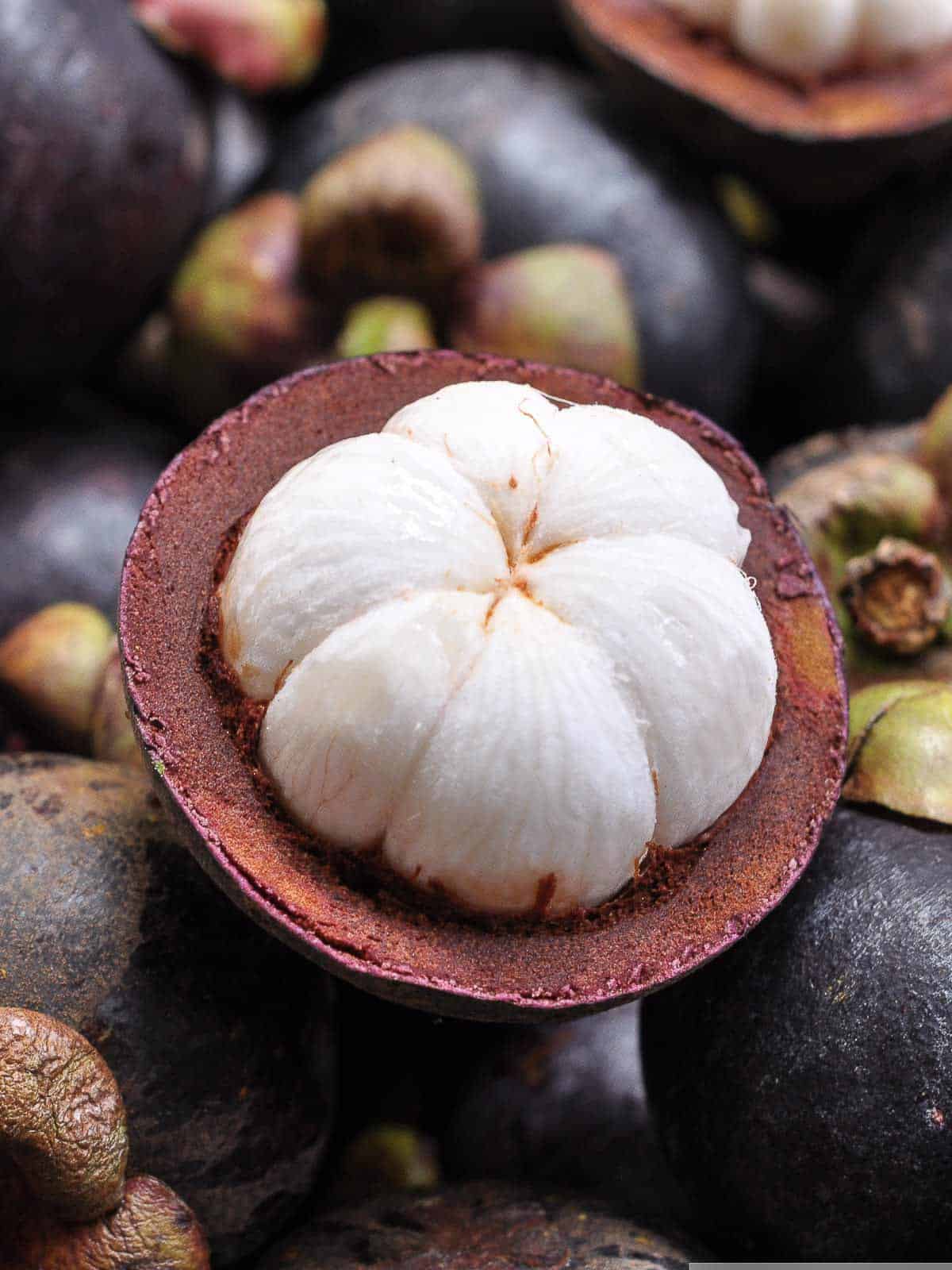The most complete list of white colour fruits, EVER. Including pictures, fun facts, and uses, I got you covered! 🤍
6 Fruits with White Skin
1. White Currant

Fun fact(s): White currants are an albino variety of red currants. They look so pretty since you can now see the inside!
Uses: Since they look so pretty, I recommend using them as toppings or garnish for your desserts or breakfast. However, you can also turn them into jams, jellies, or to add a tart flavor into your desserts!
2. White Mulberry

Fun fact(s): The fruit turns slightly pink and later on, until dark purple/black when fully ripe, which is why black mulberries also appear in my list of black fruits!
Uses: Great for smoothies, jams, dried snacks, or added to baked goods. I also love dried mulberries since they become very crunchy!
3. White Strawberry

Fun fact(s): Although white strawberries look more pale than red strawberries, they are often sweeter!
Uses: Use them the same way you would use your regular red strawberries!
4. Pineberry

Fun fact(s): Pineberries are a specific type of white strawberry. They taste a bit like a mix of pineapple and strawberry, which is where their name comes from!
Uses: Perfect for fruit salads, desserts, or as a garnish due to their unique flavor and appearance. I’d recommend them in white cakes/muffins/baked goods to make a stunning all-white dessert!
5. Honeydew

Fun fact(s): Honeydews are one of the sweetest varieties of melon!
Uses: Great for fruit salads, chilled soups, smoothies, or simply as a refreshing snack!
6. Snowberry

Fun fact(s): Snowberries are mildly toxic to both humans and animals, so resist yourself from eating them!
3 Red Fruits with White Inside
1. Apple

Fun fact(s): Apples float in water because they are 25% air!
Uses: Apples are so versatile! Use them in desserts, breakfasts, salads, juices, or just as is! You can also turn them into applesauce, which you can use in applesauce overnight oats and even in bulgogi rice bowls!
2. Rambutan

Fun fact(s): Rambutan means “hairy” in Indonesian, referring to its spiky outer shell. Despite this, rambutan has a sweet and juicy flesh!
Uses: Commonly eaten fresh, added to fruit salads, or used in tropical drinks and fruit pickles (called asinan in Indonesian).
3. Jambu Air (Rose Apple)

Fun fact(s): The different parts of rose apple plants have been used in traditional medicine to treat various ailments in many parts of Asia! (source: Specialty Produce)
Uses: Often eaten fresh, used in salads (like in rujak), or even poached (like in this Indonesian setup jambu).
3 Pink Fruits with White Inside
1. White Flesh Peach

Fun fact(s): Peaches originated in China, where it’s considered a symbol of longevity. There are also many varieties of peaches, with the yellow flesh peaches being the most popular variety in the US.
Uses: Popular in pies, cobblers, smoothies, grilled dishes, or enjoyed fresh. Peaches are truly a favorite summer fruit of mine!
2. Dragon Fruit

Fun fact(s): Dragon fruits are a type of cactus, meaning that they can withstand droughts quite well. There is also the pink variety, which appears in my List of Pink Fruits!
Uses: Use your dragon fruit in smoothies, fruit bowls, and salads, or eat it on its own. You can find a lot of them in Bali, and they quickly became my favorite breakfast fruit when I did my yoga teacher training there!
3. Lychee

Fun fact(s): Some varieties of lychee trees can live for over 1,000 years!
Uses: Lychees are often eaten fresh, in fruit salads, added to cocktails, or used in desserts. And don’t hesitate to get canned lychees (instead of fresh ones) from the supermarket since the canned ones taste great!
4 Yellow Fruits with White Inside
1. Banana

Fun fact(s): Although we mostly only see the Cavendish banana in supermarkets in the West, there are over 1,000 different banana varieties! Go to any tropical country and you will see this quickly!
Uses: Perfect for smoothies, acai bowls, baking, snacking, or adding to cereal and oatmeal. They are also great when wrapped in spring roll wrappers like in these Filipino-inspired banana rolls!
2. Asian Pear

Fun fact(s): Also known as the Nashi pear, they have a high water content and a crunchy texture with a hint of floral notes!
Uses: Often eaten fresh, added to salads, or used in desserts like tarts or poached pear dishes. They are often used in sweet dessert soup (like snow fungus soup) and they are a classic ingredient in bulgogi!
3. Canary Melon

Fun fact(s): Canary melons are named after the bright yellow color of canary birds.
Uses: Great for fruit salads, smoothies, chilled soups, or as a refreshing snack.
4. Yellow Dragon Fruit

Fun fact(s): Yellow dragon fruit is sweeter than the pink or white varieties. However, they tend to be smaller. Quality over quantity here, I guess!
Uses: Use them the same way you would use white or pink dragon fruits!
5 Brown Fruits with White Inside
1. Coconut

Fun fact(s): Coconuts are technically a fruit, a nut, and a seed all at once! (source: Library of Congress)
Uses: An essential ingredient in South East Asian cooking! They are often added into soups and curries (like in my vegan rendang) to add creaminess. Coconut milk is also often added to sweet dessert soups and even ice cream. You can also use them to make a matcha latte, or try this lavender matcha variation!
2. Cacao Flesh

Fun fact(s): The flesh is often discarded during chocolate production but it is completely edible! It’s soft, sweet, and tart with a slight citrusy note.
Uses: Cacao flesh can be eaten fresh, or used to make juices, liquors, and even fermented into beverages!
3. Longan

Fun fact(s): Longans are often called “dragon’s eye” because of their translucent flesh and dark seed👀. Their brown skin also means that they appear in my brown fruits list!
Uses: Commonly eaten fresh, added to fruit salads, or used in Asian desserts and teas.
4. Mangosteen

Fun fact(s): Also known as the “queen of fruits”, this has been said because Queen Victoria loved it so much that she promised “knighthood to anyone who would be able to bring her a mangosteen from their voyages abroad”.
Uses: They are best eaten fresh due to their soft white flesh!
5. Snakefruit (Salak)

Fun fact(s): Salak is native to Indonesia and is often a staple snack in Southeast Asia!
Uses: They are usually eaten fresh, made into fruit pickles or chips!
7 Green Fruits with White Inside
1. Green Apple

Fun fact(s): Green apples, like Granny Smith, are known for their tart flavor and firm texture.
Uses: Perfect for baking (pies, crisps), adding to salads, or snacking with peanut butter! They are also used in some curries such as the Sri Lankan curry!
2. Concorde Pear

Fun fact(s): Unlike many pears, Concorde pears stay firm even when ripe, making them great for cooking.
Uses: Concorde pears are great for poaching, baking (like a pear cake or galette), or eaten raw in salads or as a snack!
3. White Guava

Fun fact(s): Guava seeds can seem hard at first, but they are crunchy and absolutely edible!
Uses: Guavas are often eaten fresh, made into juices, jams, or added to tropical salads and desserts.
4. Cherimoya

Fun fact(s): Cherimoya has a creamy, sweet, and custard-like texture which makes it so delicious!
Uses: Best eaten fresh or added to smoothies, desserts, or chilled fruit salads.
5. Soursop (Guanabana)

Fun fact(s): Soursop has many health benefits since it is high in antioxidants, could help reduce inflammation and even kill cancer cells, as explained in this Healthline article!
Uses: They are most often used in juice and smoothies!
6. Green Papaya

Fun fact(s): Green papaya is unripe and has a crisp, mild flavor, unlike the sweet orange flesh of ripe papaya which appears on my Orange Fruits List!
Uses: It is a key ingredient in Thai dishes like in the famous Som Tum (green papaya salad). They are also often turned into pickles or incorporated into savory dishes!
7. Feijoa

Fun fact(s): Feijoa has a distinctive flavor that is often described as a mix of pineapple, guava, strawberry, and sometimes, also a touch of mint!
Uses: They are usually eaten fresh, made into jams, chutneys, or added to smoothies and desserts such as baked goods.
4 White ‘Vegetables’ That Are Actually Fruits
1. White Bell Peppers

Fun fact(s): Depending on the variety, white bell peppers might turn yellow, orange, or red as they ripen further.
Uses: Use them the same way you would use bell peppers, so for instance in sheet pan dinners (like in my tandoori veggies), in pasta (like in my creamy tandoori pasta), or even roasted to be used as a sandwich filling (like in my finger sandwiches)!
2. Baby Boo Pumpkin

Fun fact(s): Baby Boo pumpkins are small, ornamental white pumpkins, often used for decoration. However, they are also edible!
Uses: With their small size, they are great when roasted and stuffed. However, you can use them the same way you would use other pumpkins, such as in soups or pureed.
3. Lumina Pumpkin

Fun fact(s): Lumina pumpkins are large, smooth white pumpkins perfect for both carving and cooking!
Uses: Use them the same way you would use your regular pumpkin. So think of pumpkin pies, chilis, soups, and curries!
4. Carnival Squash

Fun fact(s): Carnival squash has a colorful, speckled skin with a mix of green, yellow, orange, and white. This is why it also appeared in my list of orange veggies!
Uses: Similar to most pumpkins, they are great for roasting, baking, or adding to soups and stews due to their sweet flavor!

FAQ
Curious to Find Out More?
If you enjoyed this post, you would enjoy one of the posts below!
35 White Vegetables🤍, 33 Black Vegetables or 30 Black Fruits🖤, 35 Brown Vegetables, 31 Brown Fruits🤎, 30 Orange Vegetables or 30 Orange Fruits🧡, 25 Red Vegetables❤️, 20 Yellow Vegetables💛, 25 Pink Vegetables🩷, 30 Purple Vegetables💜, or 17 Blue Vegetables💙







I enjoyed going through this list. Made me think of my travels! 🥰